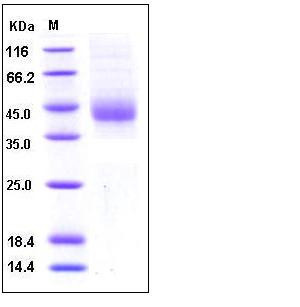Human TFPI Protein (His Tag)
EPI,LACI,TFI,TFPI1
- 100ug (NPP4303) Please inquiry
| Catalog Number | P10564-H08H |
|---|---|
| Organism Species | Human |
| Host | Human Cells |
| Synonyms | EPI,LACI,TFI,TFPI1 |
| Molecular Weight | The secreted recombinant human TFPI comprises 265 amino acids with a predicted molecular mass of 30.6 kDa. As a result of glycosylation, the apparent molecular mass of rhTFPI is approximately 42-45 kDa in SDS-PAGE under reducing conditions. |
| predicted N | Asp 29 |
| SDS-PAGE |  |
| Purity | > 85 % as determined by SDS-PAGE |
| Protein Construction | A DNA sequence encoding the human TFPI (NP_006278.1) (Met 1-Lys 282) was expressed with a C-terminal polyhistidine tag. |
| Bio-activity | Measured by its ability to inhibit trypsin cleavage of a fluorogenic peptide substrate, Mca-RPKPVE-Nval-WRK(Dnp)-NH2 (Anaspec, Catalog#27114) . The IC50 value is < 0.4 nM, as measured in 100μL reaction mixture containing 1.25 ng trypsin (Sigma, Catalog#T4799), 10 μM substrate, 50 mM Tris, 10 mM CaCl2, 0.15 M NaCl, 0.05% Brij-35, pH 7.5 . |
| Research Area | Cardiovascular |Blood |Platelet |
| Formulation | Lyophilized from sterile PBS, pH 7.4 1. Normally 5 % - 8 % trehalose, mannitol and 0.01% Tween80 are added as protectants before lyophilization. Specific concentrations are included in the hardcopy of COA. |
| Background | Tissue factor pathway inhibitor (TFPI) is the natural inhibitor of TF coagulant and signaling activities. It is a Kunitz-type serine proteinase inhibitor that down-regulates tissue factor-initiated blood coagulation. With its Kunitz domains, TFPI exhibits significant homology with human inter-alpha-trypson inhibitor and bovin basic pancreatic trypsin inhibitor. TFPI is the natural inhibitor of TF coagulant and signaling activities. The importance of TFPI in the regulation of blood coagulation is emphasized by how its activity is modulated in human disease. In a factor (F) Xa-dependent feedback system, TFPI binds directly and inhibits the TF-FVII/FVIIa complex. Normally, TFPI exists in plasma both as a full-length molecule and as variably carboxy-terminal truncated forms. TFPI also circulates in complex with plasma lipoproteins. The levels and the dual inhibitor effect of TFPI on FXa and TF-FVII/FVIIa complex offers insight into the mechanisms of various pathological conditions triggered by TF. TFPI may play an important role in modulating TF-induced thrombogenesis and it may also provide a unique therapeutic approach for prophylaxis and/or treatment of various diseases. In addition, Studies have shown that TFPI exhibits antiangiogenic and antimetastatic effects in vitro and in vivo. In animal models of experimental metastasis, both circulating and tumor cell-associated TFPI are shown to significantly reduce tumor cell-induced coagulation activation and lung metastasis. |
| Reference |
